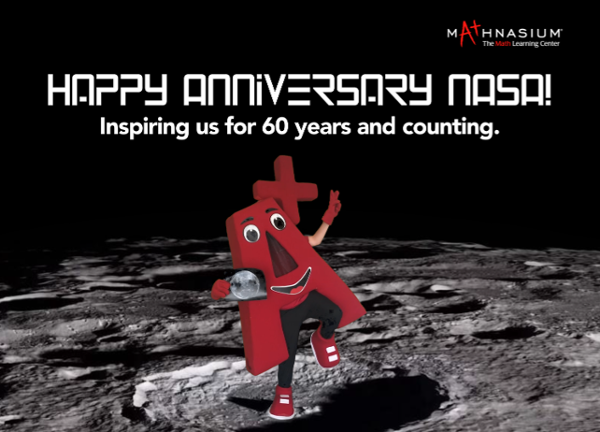Sixty years ago, on October 1, 1958, the National Aeronautics and Space Administration (NASA) as we know it was established and our world was changed for the better. As math and STEM lovers, we are very excited to celebrate this incredible anniversary, along with the mathematicians, scientists, and visionaries who have made it possible!
NASA grew out of the National Advisory Committee for Aeronautics (NACA) which had existed since 1915 and had been the driving force for aeronautic progress and innovation during WWI and WWII. After the incredible leaps forward in science and rocketry in the 1940s and 1950s (including the Soviet launch of Sputnik in 1957) President Eisenhower and the U.S. Congress decided that it was time to turn American efforts toward our own space exploration program.
NASA was established with a civilian focus rather than a military one, the idea being that it would search for peaceful applications for space science. Since it's inception in the 1950s, NASA has led almost all of the U.S. space exploration efforts, including those listed below.
Project Mercury (1959-1963) - The first manned U.S. space program.
The Apollo Missions (1961-1972) - The Apollo missions were unique in sending humans beyond low-earth orbit, culminating in Neil Armstrong from Apollo 11 being the first man to set foot on the moon. Later Apollo missions were responsible for sending 11 other people to the moon, returning with a wealth of scientific data.
Skylab (1973-1974) - The first American space station.
Voyager (1977) - Voyager I and Voyager II were robotic probes launched to travel to the far reaches of our solar system, sending data back to earth. Attached to the probes are golden records, which contain information and sounds intended to portray the diversity of life on Earth to any extra-terrestrial life which the Voyager probes may come into contact with. On August 25, 2012 Voyager I became the first man-made object to enter interstellar space, where (as far as we know) it continues to travel to this day.
Space Shuttle Program (1972-2011) - These relaunchable and reusable space exploration vehicles have allowed numerous exploratory missions as well as collaboration between countries on further space developments.
The International Space Station (1993-present) Joint project between the U.S., Russia, Canada, Europe, and Japan. The ISS is still in orbit around the Earth, populated by up to 7 scientists at a time of varying nationalities, and can be seen in the night sky with the naked eye.
Mars Exploration (1965-present) - NASA's Mariner 4 in 1965 was the first successful fly-by of Mars. Since then NASA Mars missions have included Viking, Pathfinder, Odyssey, Curiosity, and MAVEN, just to name a few.
Throughout the decades NASA has helped us learn more about ourselves and our world by exploring our universe, it has inspired national and individual pride as we watched NASA scientists and astronauts accomplish seemingly impossible feats of space travel, and it has motivated us to look toward the stars, put our STEM skills to good use, and dream of new possibilities for ourselves and for our children.
Happy 60th anniversary NASA! Here's to many more decades of exploration and accomplishment.











